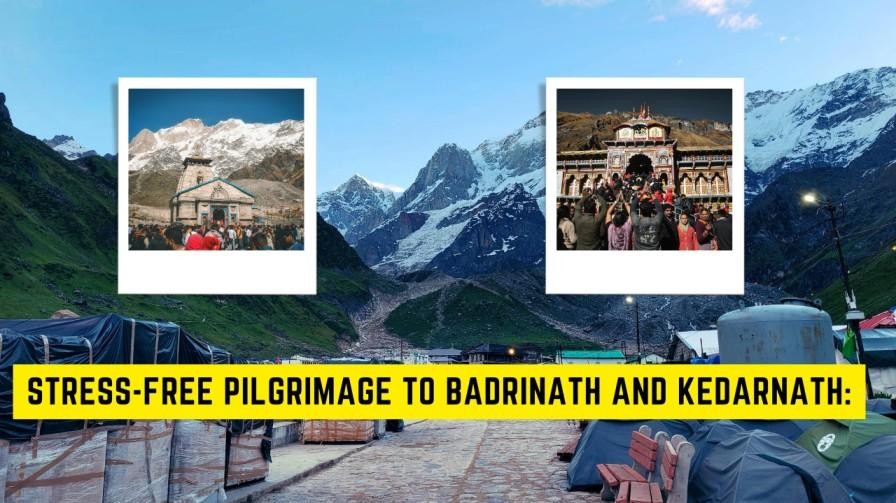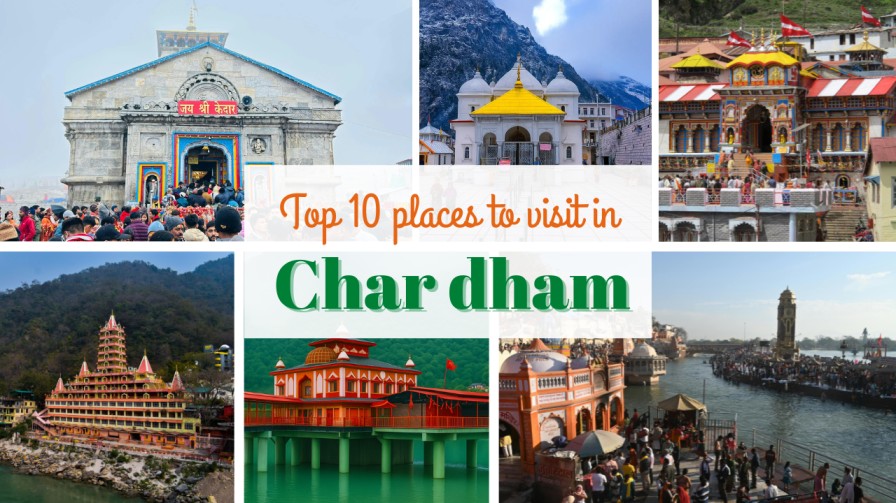Introduction – The Land Where Gods Walk the Earth Uttarakhand isn’t just a destination — it’s a feeling.Known as Devbhumi, or “The Land of the Gods,” this Himalayan state holds centuries of spiritual heritage, where rivers are sacred, mountains are divine, and every temple has a story to tell. Whether it’s the echoing chants in Kedarnath, the peaceful ghats of Haridwar, or the mystical silence of Jageshwar — every corner of Uttarakhand breathes devotion. In this Uttarakhand temple travel guide 2026, we’ll walk you through the most famous temples in Uttarakhand, their history, how to reach them, and the best time to experience their divine charm. Let’s begin your spiritual journey. 1. Kedarnath Temple – The Soul of Shiva If there’s one temple that defines Uttarakhand’s divinity, it’s Kedarnath Temple. Perched at an altitude of 11,755 feet, this sacred shrine is one of the most visited temples in Uttarakhand and part of the holy Char Dham Yatra. Dedicated to Lord Shiva, the temple stands bravely amidst the snow-covered Himalayas — a symbol of faith that has withstood floods, earthquakes, and time itself. Why Visit: How to Reach:Trek 16 km from Gaurikund (can also hire ponies or palanquins). Helicopter services are available from Guptkashi and Phata. Best Time to Visit: May to October (temple remains closed in winter). 2. Badrinath Temple – The Abode of Lord Vishnu Situated along the Alaknanda River, Badrinath Temple is one of the most sacred Hindu temples in Uttarakhand. It’s believed that Lord Vishnu meditated here under the Badri tree, while Goddess Lakshmi sheltered him as a form of love. The temple’s bright colors, snow peaks, and divine serenity make it a must-visit for every devotee. Why Visit: Best Time to Visit: May to October 3. Gangotri Temple – The Sacred Birthplace of the Ganges At 10,200 feet above sea level, Gangotri Temple marks the origin of the River Ganga — believed to have descended from heaven to cleanse humanity of its sins. The white stone temple stands gracefully beside the Bhagirathi River, surrounded by snow peaks and pine forests. Highlights: Travel Tip: Combine Gangotri with nearby Harsil village for a peaceful stay. Best Time to Visit: May to October 4. Yamunotri Temple – Origin of the River Yamuna Located in the western Garhwal Himalayas, Yamunotri Temple is the first stop in the Char Dham Yatra. Dedicated to Goddess Yamuna, this temple is surrounded by glaciers and thermal springs. Pilgrims trek from Janki Chatti to reach the shrine, passing through waterfalls and rhododendron forests. Why Visit: Best Time: May to October 5. Tungnath Temple – The Highest Shiva Temple in the World Nestled at 12,000 feet in the Chandrashila range, Tungnath is not just a temple — it’s a feeling of being closer to the divine. Believed to be built by the Pandavas, this is the highest Shiva temple in the world. The short 4 km trek from Chopta is scenic, with meadows, forests, and views of snow peaks. Highlights: Best Time: April to November 6. Jageshwar Dham – The Ancient Valley of Temples Hidden amidst the deodar forests of Almora, Jageshwar Dham is one of the most peaceful spiritual places to visit in Uttarakhand. It’s a complex of over 120 stone temples dating back to the 9th century, all dedicated to Lord Shiva. The place is serene, historic, and filled with positive energy. Why Visit: Best Time: April to June, September to November 7. Dhari Devi Temple – The Protector Goddess of Uttarakhand Located between Srinagar and Rudraprayag, Dhari Devi Temple is dedicated to Goddess Kali in her fierce form. The temple stands on a small rock island in the Alaknanda River. Locals believe she protects Uttarakhand from calamities, and her idol is half submerged in water — changing form with time of day. Unique Belief:Morning – Child formAfternoon – Young womanEvening – Old lady Best Time: March to June, September to November 8. Kalimath Temple – The Power of Shakti Among the 108 Shakti Peethas, Kalimath Temple near Guptkashi is one of the holiest. Dedicated to Goddess Kali, it’s believed that she killed the demon Raktabeej here and disappeared into the ground. The idol is not visible — she is worshipped underground, symbolizing divine power hidden in the earth. Why Visit: Best Time: March to June, September to November 9. Neelkanth Mahadev Temple – Shiva’s Mythical Shrine Located just 30 km from Rishikesh, Neelkanth Mahadev Temple sits at 1,300 meters, surrounded by dense forests and valleys. It marks the spot where Lord Shiva drank poison from the churning of the ocean (Samudra Manthan), turning his throat blue — earning him the name Neelkanth (Blue Throat). Highlights: Best Time: October to March 10. Surkanda Devi Temple – Where Faith Meets the Sky Located near Dhanaulti, Surkanda Devi Temple is one of the most beautiful Hindu temples in Uttarakhand. It’s said to be the place where Goddess Sati’s head fell when Lord Shiva carried her burned body after the Daksha Yagna. To reach the temple, devotees hike about 2 km uphill through pine forests, rewarded with a stunning 360° view of the Himalayas and Doon Valley. Best Time: March to June, September to November 11. Nanda Devi Temple – Goddess of the Himalayas Located in Almora, Nanda Devi Temple is dedicated to the goddess regarded as the protector of Uttarakhand. The temple’s annual Nanda Devi Fair is a colourful celebration of culture, devotion, and local traditions. Highlights: 12. Baijnath Temple – Lord Shiva’s Eternal Presence Situated along the Gomti River in Bageshwar, Baijnath Temple is known for its timeless stone architecture and mythological link — it is believed Lord Shiva married Goddess Parvati here. Why Visit: Best Time: October to March 13. Kainchi Dham Temple – The Ashram of Miracles Kainchi Dham near Nainital is a modern spiritual site that gained global fame due to Neem Karoli Baba, a saint revered for his wisdom and miracles. It’s visited by thousands, including tech icons like Steve Jobs and Mark Zuckerberg, who credited their visits here for
Stress-Free Pilgrimage to Badrinath and Kedarnath
A journey to Badrinath and Kedarnath is considered one of the most sacred pilgrimages in India. However, without proper preparation, it can easily become exhausting. To make the trip peaceful and fulfilling, it is advised that everything—from travel mode to accommodation—be planned in advance. When arrangements are made beforehand, the journey becomes less stressful and far more spiritually enriching. With careful preparation, the journey is not just about reaching temples but also about feeling divine energy throughout. Packing light, registering early, and choosing the best travel route ensures that the entire yatra remains organized and calm. As a result, the focus stays on prayers and peace rather than logistics or delays. Spiritual Importance of Badrinath and Kedarnath The temples of Badrinath and Kedarnath are regarded as two of the holiest shrines in Hinduism. They represent balance in nature—Vishnu as the preserver and Shiva as the transformer. Both are visited by millions of devotees every year to seek blessings and liberation from worldly attachments. Badrinath is associated with Lord Vishnu, who is believed to have meditated here amid the Himalayas. Kedarnath is dedicated to Lord Shiva, who is worshipped as one of the twelve Jyotirlingas. Together, they signify harmony between creation and destruction, devotion and detachment, and action and stillness. Moreover, both temples are surrounded by majestic snow-clad peaks, where silence and faith merge seamlessly. The serene environment allows devotees to experience an overwhelming sense of spiritual awakening. Badrinath – The Abode of Lord Vishnu Badrinath is regarded as a symbol of purity, preservation, and divine knowledge. It is believed that Lord Vishnu meditated here for thousands of years. The temple stands as part of the Char Dham Yatra, and visiting it is said to cleanse the soul and remove sins. Connection to Ancient Scriptures In several Hindu scriptures, including the Vedas and the Mahabharata, references to Badrinath can be found. It is mentioned that Lord Vishnu came here in human form to bless mankind. The temple’s history is so deeply rooted in spirituality that even today, chanting and rituals performed here are believed to purify one’s heart and mind. Energy of the Himalayas Surrounded by towering peaks and clear rivers, the region’s energy feels divine. It is said that nature itself meditates here. Pilgrims often describe that their worries seem to disappear as they step into the sacred valley. The sound of bells and the cool mountain breeze make the spiritual experience even more profound. Symbol of Devotion and Liberation Praying at Badrinath is believed to lead one closer to moksha—spiritual liberation. Many devotees say that true peace is achieved not by reaching the temple but by surrendering completely to the divine will. As a result, Badrinath is often described as a pathway to inner freedom. Kedarnath – The Abode of Lord Shiva The Kedarnath Temple, located at an altitude of 3,583 meters, is one of the most revered sites in Shaivism. It is believed that Lord Shiva appeared here to bless the Pandavas after the great war of Mahabharata. Every year, thousands of pilgrims visit to seek forgiveness and divine strength. Mythological Importance According to legends, the Pandavas searched for Lord Shiva to repent for their sins. To avoid them, Shiva transformed into a bull and disappeared into the earth at Kedarnath. The hump of the bull was left behind, forming the temple’s main shrine. It is believed that worshipping at this spot washes away one’s sins and grants eternal peace. Peace and Meditation Located in the lap of the Himalayas, Kedarnath offers unmatched serenity. The stillness of the mountains, combined with the chanting of mantras, creates an atmosphere of divine calm. Many devotees meditate here to feel closer to Lord Shiva’s energy, which is believed to be strongest at dawn and dusk. Path to Moksha It is often said that those who visit Kedarnath with pure devotion are freed from the cycle of birth and death. The journey is not easy, yet every challenge faced on the way becomes part of the spiritual test. As the soul surrenders to faith, inner transformation naturally follows. Combined Significance of Both Temples Visiting both Badrinath and Kedarnath together is believed to bring complete spiritual fulfillment. Lord Vishnu and Lord Shiva, though different in form, are considered two sides of the same cosmic truth. One represents sustenance and the other liberation. Therefore, devotees feel that both must be visited to attain balance in life. Moreover, both sites are located amid natural beauty, where rivers like the Alaknanda and Mandakini flow endlessly, reminding visitors of life’s continuity. The chanting of hymns, the ringing of temple bells, and the sight of mountains covered in snow together create an unforgettable spiritual experience. Best Time to Visit for a Peaceful Yatra The best months to visit are from April to June and September to October. During these months, the weather remains pleasant, and the temples are open for darshan. The post-monsoon period offers clear skies, calm surroundings, and comfortable trekking routes. It is advised that pilgrims plan their yatra within the recommended months to avoid natural challenges. How to Reach Badrinath and Kedarnath Both temples are well connected by road, rail, air, and helicopter services. By Road Badrinath can be reached from Rishikesh (314 km), Haridwar (298 km), and Dehradun (301 km).Kedarnath can be accessed via Gaurikund, which is 222 km from Rishikesh. From there, a 16 km trek or pony ride leads to the temple. Road travel is preferred by most pilgrims as it offers scenic views of valleys and rivers. By Train The nearest railway station is Rishikesh, well-connected to major cities.From Rishikesh or Haridwar, taxis and buses are available to reach the base camps. By Air The closest airport is Jolly Grant Airport (Dehradun).Helicopter services to Phata, Guptkashi, and Kedarnath are operated during the yatra season. For Badrinath, limited flights are available from Dehradun.It is recommended that seats be booked in advance as weather may affect flight schedules. Accommodation and Pre-Booking Booking accommodations in advance is highly advised. It helps in avoiding
Top 10 Things to Do in Char Dham Yatra – A Complete Travel Guide
Understanding Char Dham Yatra The word “Char Dham” is made up of two Hindi words — Char meaning four and Dham meaning temple or holy place. Therefore, Char Dham Yatra means the sacred journey to four divine shrines of India. Interestingly, India has two types of Char Dham pilgrimages. The first is the Main Char Dham, which includes Badrinath in Uttarakhand, Dwarkadhish in Gujarat, Jagannath Puri in Odisha, and Rameshwaram in Tamil Nadu. Each of these temples represents one direction of the country — north, west, east, and south — symbolizing the spiritual unity of India. However, the second type, known as the Chota Char Dham Yatra, is located entirely in Uttarakhand. This smaller yet spiritually powerful circuit attracts millions of pilgrims every year. Moreover, this Himalayan Char Dham includes Yamunotri, Gangotri, Kedarnath, and Badrinath, each holding deep mythological and cultural importance. You can also read our travel guide on Hidden Gems of Uttarakhand to explore lesser-known spiritual spots in the Himalayas. The Himalayan Char Dham – A Journey of Faith The Chota Char Dham Yatra unfolds through the Garhwal region of Uttarakhand, offering not only spiritual enlightenment but also breathtaking natural beauty. To begin with, the journey starts at Yamunotri, dedicated to Goddess Yamuna — believed to grant longevity and freedom from untimely death. Next comes Gangotri, where Goddess Ganga descended from heaven to cleanse humanity’s sins. After that, the path leads to Kedarnath, one of the twelve Jyotirlingas of Lord Shiva, where pilgrims often carry holy water from Gangotri to offer to the deity. Finally, the yatra concludes at Badrinath, devoted to Lord Vishnu, representing salvation and peace. Furthermore, each destination carries a unique story and spiritual vibration that deepens your connection with faith. It’s not just a route — it’s a path toward awakening. For updated temple timings and route maps, visit the official Uttarakhand Tourism website. 1. Follow the Trail of Myths and Legends Every temple in the Char Dham Yatra is rooted in ancient mythology. For example, Kedarnath is believed to be the place where the Pandavas sought Lord Shiva’s forgiveness after the Mahabharata war. Similarly, at Yamunotri, Goddess Yamuna is worshipped as the sister ohttp://bhjf Yama, the God of Death, and it is believed that bathing here ensures liberation from the fear of death. In addition, listening to these fascinating legends from local priests and villagers adds depth and wonder to your spiritual journey. As you travel, you realize that every mountain, river, and stone here has a story to tell. You may also like our blog on Is Rishikesh Just for Yoga? 10 Other Things You Didn’t Know You Could Do for exploring more spiritual activities in Uttarakhand. 2. Participate in Sacred Rituals While visiting these temples, don’t just observe — participate in the rituals. At Badrinath, many devotees perform Pind Daan or Shraddha rituals for their ancestors. Meanwhile, at Gangotri, people offer Tarpan to honor their departed loved ones in the sacred waters of the Ganga. Moreover, these age-old traditions bring emotional healing. They remind us that spirituality is not only about worshiping deities but also about staying connected to our roots and expressing gratitude for our lineage. 3. Discover Hidden Temples and Spots Beyond the four main shrines, several hidden gems await exploration. For instance, near Yamunotri, lies the Shani Dev Temple, known for its tranquil surroundings. Likewise, near Badrinath, you can visit Vasudhara Falls, where the cascading waters are believed to purify the soul. Additionally, visiting such lesser-known places gives you moments of peace away from the crowd, allowing you to connect deeply with nature and yourself. 4. Serve at Langars – The Joy of Seva Along the entire Char Dham route, you’ll find numerous langars (community kitchens) serving free meals to pilgrims. Volunteering at these langars — whether by cooking, serving food, or cleaning utensils — is a deeply humbling experience. It teaches you that seva (service) is another form of worship. Furthermore, helping others fills your heart with warmth and gratitude, reminding you that spirituality is best expressed through kindness. You can find volunteer opportunities listed on Badrinath-Kedarnath Temple Committee’s official website. 5. Explore the Origin of Sacred Rivers The Char Dham Yatra is not only about temples; it’s also about the rivers that give life to India. You can trek to Gaumukh Glacier, the origin of the River Ganga, or explore Saptrishi Kund, the source of the Yamuna River. These high-altitude treks are challenging yet profoundly rewarding. In addition, witnessing these origins helps you appreciate how faith and nature coexist. The sound of gushing waters and the sight of majestic peaks together create a moment of divine realization. 6. Chant Mantras by the Rivers At dusk, sit beside the riverbanks and chant “Om Namah Shivaya” or the Gayatri Mantra. The soothing sound of flowing rivers, the ringing temple bells, and the crisp mountain air together create an atmosphere of peace. Moreover, such meditation connects your soul with the divine energy that surrounds you. 7. Admire Himalayan Flora and Fauna The Char Dham route passes through valleys filled with vibrant Himalayan flora and fauna. You may encounter the Brahma Kamal, Uttarakhand’s state flower, near Badrinath, or spot Himalayan Monals and Musk Deer in higher regions. In addition, during spring, the entire valley blooms in shades of pink, yellow, and green, making the journey even more enchanting. Thus, the pilgrimage becomes a perfect balance between spiritual awakening and natural wonder. Learn more about the region’s biodiversity at Valley of Flowers National Park (UNESCO) 8. Join Eco-Friendly Activities Since thousands of devotees visit every year, maintaining cleanliness is crucial. Several local groups and NGOs organize clean-up drives and tree-planting campaigns along the yatra route. Participating in these initiatives is a small act with a big impact. Moreover, by contributing to nature’s preservation, you ensure that future generations experience the same serenity and beauty. 9. Meet the Himalayan Sages Throughout your journey, you may come across sages and hermits meditating in caves or living in solitude near the temples. Speaking




